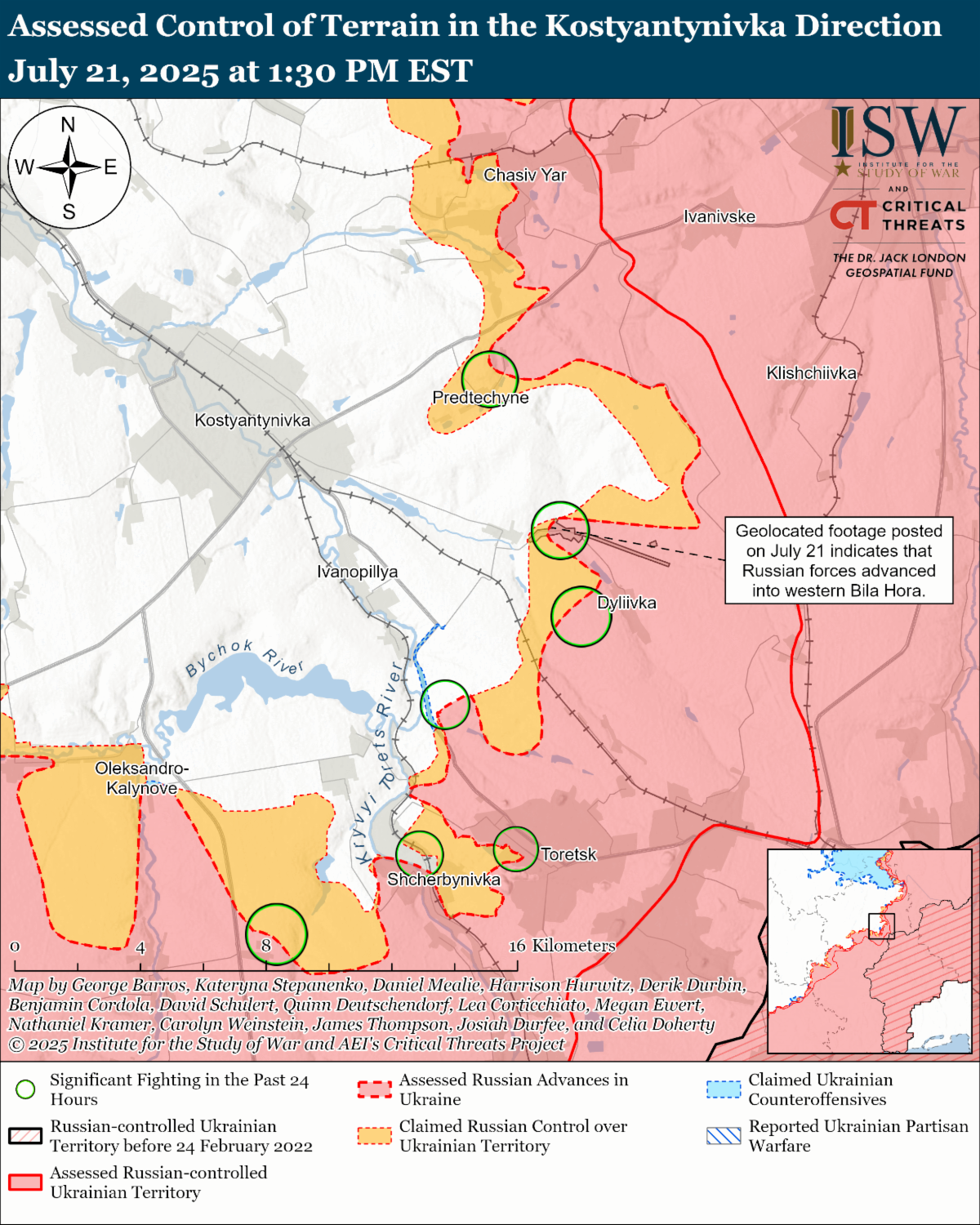Russian forces conducted a large-scale series of missile and drone strikes against Ukraine on the night of July 20 to 21 that included over 400 drones as Russia continues to launch significantly larger strike packages in June and July 2025 than in January to May 2025. The Ukrainian Air Force reported that Russian forces launched 426 Shahed-type strike drones and decoy drones from the directions of Bryansk and Oryol cities; Millerovo, Rostov Oblast; Shatalovo, Smolensk Oblast; and Primorsko-Akhtarsk, Krasnodar Krai. The Ukrainian Air Force reported that Russian forces also launched five Kh-46 Kinzhal aeroballistic missiles from the airspace over Tambov Oblast; four Kalibr cruise missiles from the Black Sea; one Iskander-K cruise missile from Millerovo; and 14 Kh-101 cruise missiles from the airspace over Saratov Oblast. The Ukrainian Air Force reported that Ukrainian forces shot down and suppressed 200 Shahed-type drones and 203 decoy drones that Ukrainian air defense fire and electronic warfare (EW) downed all the missiles. The Ukrainian Air Force reported that 23 strike drones hit three locations and that drone debris fell in 12 locations. Ukrainian officials reported that Russian strikes damaged civilian and critical infrastructure in Ivano-Frankivsk, Kyiv, and Kharkiv oblasts. Kyiv City Military Administration Head Timur Tkachenko reported that the Russian strike damaged the entrance to a metro station in the city. Ukrainian President Volodymyr Zelensky stated that the Russian strikes injured 15 civilians and killed two. Russia rarely launched over 200 drones per night between January and May 2025, and an overnight strike package consisting of over 400 drones — even if far below Russia's latest record high of 728 drones in one strike package — demonstrates the dramatic shift in Russia's ability to repeatedly launch larger-scale drone strikes in recent weeks since May 2025.
Ukraine's Western partners pledged additional military and financial assistance to Ukraine during a virtual meeting of the Ukraine Defense Contact Group (the Ramstein format) on July 21. Ukrainian Defense Minister Denys Shmyhal announced that Germany will transfer five Patriot air defense systems to Ukraine in the near future and that Germany will also send 200,000 Gepard shells to Ukraine. German Defense Minister Boris Pistorius also confirmed that Germany will send five Patriot air defense systems and necessary interceptors to Ukraine. Shmyhal stated that Canada will contribute an unspecified amount toward financing Ukraine's defense industrial base (DIB) via the "Danish model" (in which Ukraine's partners buy Ukrainian-manufactured weapons for the Ukrainian military) and allocated 20 million CAD ($14.6 million) to Ukrainian tank maintenance. Shmyhal stated that the Netherlands allocated 200 million euros (roughly $234 million) to fund Ukrainian production of interceptor drones to counter Russian Shahed-type drones and 125 million euros (roughly $146 million) for F-16 fighter jet maintenance. Shmyhal stated that Norway also allocated one billion euros (roughly $1.67 billion) to fund Ukrainian drone purchases in 2025, including 400 million euros (roughly $468 million) specifically to purchase drones from Ukraine's DIB.
British Defense Secretary John Healey announced during the Ukraine Defense Contact Group meeting on July 21 a "50-day drive" to arm Ukraine on the battlefield and help push Russian President Vladimir Putin to the negotiating table. Healey noted that the group needs to seize on US President Donald Trump's threat to impose "severe" 100 percent secondary tariffs on Russia's trade partners if there is no peace settlement to end Russia's war in Ukraine within 50 days from July 14. ISW has consistently assessed that only significant Russian battlefield setbacks, enabled by timely and sufficient Western military assistance to Ukrainian forces, will force Putin to reconsider Russia's ability to militarily defeat Ukraine and bring him to the negotiating table. Such setbacks will not happen in a matter of weeks and will likely require several months or campaign seasons, assuming that the West commits to properly equipping and aiding Ukrainian forces to the point that Ukraine could successfully conduct such operations.
Ukrainian officials discussed Ukraine's increasing defense industrial capacity amid ongoing European aid announcements. Ukrainian Defense Minister Denys Shmyhal stated that Ukraine's defense industrial base (DIB) can accommodate an additional $6 billion in investments and that Ukraine could use these funds to produce more first-person view (FPV) and interceptor drones and long-range weapons. Ukrainian President Volodymyr Zelensky stated that Ukraine intends to increase domestic defense production over the next six months. Ukrainian Defense Procurement Agency Head Arzen Zhumadilov told Ukrainian television channel Kanal 24 that Ukraine has contracted with three companies, including one Ukrainian and one American company, to produce interceptor drones to counter Russian Shahed-type drones. Zhumadilov stated that Ukraine's DIB currently has the capacity to produce eight to 10 million FPV drones per year but that the Ukrainian government will only be able to fund the procurement of four to 4.5 million drones in 2025 due to budgetary constraints.
Key Takeaways:
- Russian forces conducted a large-scale series of missile and drone strikes against Ukraine on the night of July 20 to 21 that included over 400 drones as Russia continues to launch significantly larger strike packages in June and July 2025 than in January to May 2025.
- Ukraine's Western partners pledged additional military and financial assistance to Ukraine during a virtual meeting of the Ukraine Defense Contact Group (the Ramstein format) on July 21.
- British Defense Secretary John Healey announced during the Ukraine Defense Contact Group meeting on July 21 a "50-day drive" to arm Ukraine on the battlefield and help push Russian President Vladimir Putin to the negotiating table.
- Ukrainian officials discussed Ukraine's increasing defense industrial capacity amid ongoing European aid announcements.
- Ukraine officially proposed a third round of negotiations with Russia amid speculation in the Ukrainian and Russian informational spaces. Russian officials continue to feign interest in good-faith negotiations, despite failing to propose or agree to a third round of negotiations.
- Ukrainian forces recently advanced in northern Sumy Oblast. Russian forces recently advanced in northern Sumy Oblast and near Chasiv Yar, Toretsk, and Pokrovsk.
| 




 [ISW] 이란 업데이트, 2025년 7월 21일
[ISW] 이란 업데이트, 2025년 7월 21일